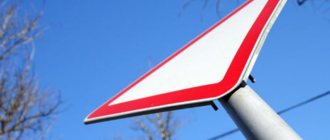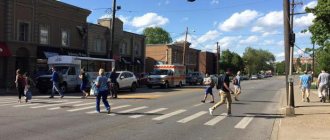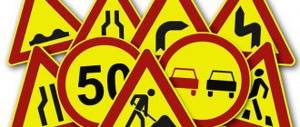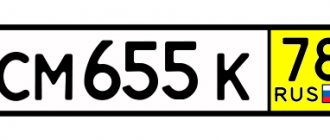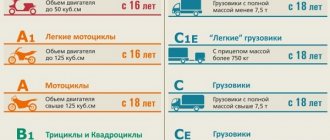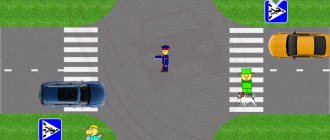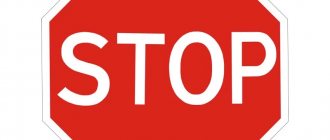- 6.1
- 6.2
- 6.3
- 6.4
- 6.5
- 6.6
- 6.7
- 6.8
- 6.9
- 6.10
- 6.11
- 6.12
- 6.13
- 6.14
- 6.15
- 6.16
6. TRAFFIC LIGHTS AND CONTROLLER SIGNALS
And only red, yellow color is indisputable, Green too, greenery is in chlorophyll. Therefore, traffic lights are three-colored For those who are on foot and who are in the car.
V. Vysotsky
6.1
Traffic lights use green, yellow, red and white-lunar light signals
Depending on the purpose, traffic light signals can be round, in the form of an arrow(s), a silhouette of a pedestrian or a bicycle, or X-shaped. Traffic lights with round signals may have one or two additional sections with signals in the form of a green arrow(s), which are located at the level of the green round signal.
Reader A:
Why were these particular colors chosen to regulate traffic and red was made prohibitive, yellow – warning, and green – permissive?
Author:
This is due to the fact that red light rays propagate best in the atmosphere. In rainy and foggy weather, as well as at night, they are visible at a considerable distance. But this is very important for a prohibitory signal. The yellow signal is visible worse than the red one, but better than the green one. It is clearly visible and is most suitable for a warning signal. Well, the permissive traffic light signal was made green so that it can be easily distinguished from the prohibitory and warning signals.
Readers A and B:
We know most of the traffic lights, but we are hearing about some for the first time.
Author:
Let's try to figure it out. The traffic lights discussed in this section of the Rules are shown in our book on a color insert.
6.2
Round traffic lights have the following meanings:
GREEN SIGNAL allows movement;
A GREEN FLASHING SIGNAL allows movement and informs that its time is expiring and a prohibitory signal will soon be turned on (digital displays can be used to inform drivers about the time in seconds remaining until the end of the green signal);
YELLOW SIGNAL prohibits movement, except as provided for in paragraph 6.14 of the Rules, and warns of an upcoming change of signals;
A YELLOW FLASHING SIGNAL allows movement and informs about the presence of an unregulated intersection or pedestrian crossing, and warns of danger;
A RED SIGNAL, including a flashing one, prohibits movement. The combination of red and yellow signals prohibits movement and informs about the upcoming activation of the green signal.
Reader A:
The purpose of the red and green signals is known to everyone
Reader B:
What about the rest? How to behave in a situation when the green signal flashes?
Author:
I would like to immediately note that the green flashing signal does not prohibit movement. In such conditions, depending on the situation, taking into account the condition of the roadway and the density of traffic flow, the driver must independently make a decision: either reduce the speed and stop, or continue driving, increasing the speed within the permitted limits.
Reader A:
How long does the green light blink?
Author:
Usually - 3-4 seconds. The yellow light is on for the same amount of time. All this increases the time it takes to warn traffic participants about the red light turning on.
Reader B:
We've sorted out the green flashing signal, but what should we do when the yellow one turns on, when it warns of an upcoming change of signals?
Author:
If the yellow signal turns on after the red one, then movement is still prohibited. But when the green signal is replaced by yellow, then you can continue driving only if you have to resort to emergency braking to stop (see paragraph 6.14 of the Rules)
6.3
Traffic light signals made in the form of red, yellow and green arrows have the same meaning as round signals of the corresponding color, but their effect extends only to the direction(s) indicated by the arrows. In this case, an arrow allowing a left turn also allows a U-turn if this is not prohibited by the corresponding road sign. The green arrow in the additional section has the same meaning. The switched off signal of the additional section means prohibition of movement in the direction regulated by this section
Author:
This paragraph of the Rules deals with two types of traffic lights
The first is traffic lights, on all three main signals of which you will see arrows. These are directional traffic lights. They regulate traffic along each lane above which they are located, making it easier for drivers to navigate (Fig. 71)
Reader A:
Are their signals similar to those of a regular traffic light?
Author:
Yes.
Reader B:
This means that with the red and yellow signals of such a traffic light, as usual, we stand still, and when the green signal lights up, movement is allowed only in the direction of the arrow or arrows shown on it
Author:
True The second type of traffic lights, which are discussed in paragraph 6.3 of the Rules, are traffic lights with an additional section. You can move in the direction of the arrow in the additional section only when it is turned on.
Reader B:
This is very convenient. The arrow in the additional section does not light up - you are standing still, it lights up, and you are moving.
Author:
Take your time, dear reader. Remember, if the green arrow in the additional section is turned on simultaneously with the red signal of the main section of the traffic light, then when moving in the direction of the green arrow, you must give way to vehicles coming from other directions (clause 13.5 of the Rules) (Fig. 72).
Reader A:
Of course, they should, since drivers moving from other directions go to the green signal of the main section of the traffic light, and in front of us in the main section there is a red signal.
6.4
If a black contour arrow(s) is applied to the main green traffic light signal, it informs drivers about the presence of an additional section of the traffic light and indicates other permitted directions of movement than the additional section signal.
Author:
This is especially important in the dark. Because if the additional section is not turned on, drivers will not always be able to understand that the traffic light is equipped with it. To prevent an erroneous turn when the additional section is turned off (Fig. 73), a black contour arrow(s) is applied to the lens of the main green signal.
6.5
If the traffic light signal is made in the form of a silhouette of a pedestrian (bicycle), then its effect applies only to pedestrians (cyclists). In this case, the green signal allows, and the red one prohibits the movement of pedestrians (cyclists). To regulate the movement of cyclists, a traffic light with round signals of reduced size can also be used, supplemented by a rectangular white plate measuring 200x200 mm with an image of a black bicycle.
6.6
To inform blind pedestrians about the possibility of crossing the roadway, traffic light signals can be supplemented with an audible signal.
6.7
To regulate the movement of vehicles along lanes of the roadway, in particular along those in which the direction of movement can change to the opposite, reversible traffic lights with a red X-shaped signal and a green signal in the form of an arrow pointing downwards are used. These signals respectively prohibit or enable
(Fig. 74 and 75)
movement along the lane above which they are located
The main signals of a reversible traffic light can be supplemented by a yellow signal in the form of an arrow inclined diagonally down to the right or to the left, the inclusion of which informs about the upcoming change of signal and the need to change lanes, on which the arrow points to
(Fig. 76)
Author:
When the signals of the reversible traffic light located above the lane marked on both sides by markings 1.9 are turned off, entry into this lane is prohibited (Fig. 77).
Reader A:
What does "reversible" mean?
Author:
“Reversible” - translated from Latin - reverse. On the road there may be a lane or several lanes, the direction of movement along which, depending on the situation, changes to the opposite. For example, in the morning most of the cars from the “sleeping” areas of the city move to the center, and in the evening, vice versa
Lanes in which the direction of movement can change to the opposite are called reversible, and are usually marked on the roadway with a double broken marking line 1.9 A reversible traffic light is installed above such a lane. It only affects the lane above which it is located.
Reader A:
As far as I understand from the instructions in clause 6.7 of the Rules, you can enter such a lane only in one case, when the green arrow is on at the reverse traffic light (Fig. 75)
Author:
Absolutely right. The procedure for driving on reversible lanes is specified in Appendix 2 to the Rules of the Road in section 1 “Horizontal markings”.
6.8
To regulate the movement of trams, as well as other route vehicles moving along the lane allocated for them, single-color traffic lights with four round white-moon-colored signals located in the shape of the letter “T” can be used. Movement is permitted only when the lower signal and one or several upper ones, of which the left one allows movement to the left, the middle one - straight ahead, the right one - to the right. If only the top three signals are on, movement is prohibited.
Reader B:
Is it worth remembering the signals of this traffic light? We are not going to drive trams and other route vehicles.
Author:
It's definitely worth it, especially since it's not difficult at all. The fact is that trams, while simultaneously having the right to travel with trackless transport, have an advantage (clauses 13.6 and 13.11 of the Rules). We will discuss these instructions in the Rules in detail in the future. So, if such a traffic light allows the tram to move in the same situation as a trackless vehicle, then you are obliged to give way to it (Fig. 78–80), and if it prohibits it, then you can move first (Fig. 81)
Reader A:
Yes, it turns out that we too must be guided by the signals of this traffic light.
6.9
A round white-lunar flashing signal located at a railway crossing allows the movement of vehicles through the crossing. When the flashing white-lunar and red signals are turned off, movement is permitted if there is no train (locomotive, railcar) approaching the crossing within sight.
Author:
When the signal of such traffic lights is red, it is prohibited to enter the crossing; when the signal is white and slowly flashing, it is allowed (Fig. 82).
Reader B:
That is, the white, slowly flashing traffic light signal in front of a railway crossing is equal in value to the green signal of an ordinary traffic light.
Author:
Right. But be very careful if the traffic light signal is turned off at the crossing. In this case, before leaving for the crossing, you must independently assess the situation, since the traffic light is no longer your guide.
The procedure for crossing railway crossings is discussed in section 15 of the Rules
6.10
The traffic controller signals have the following meanings.
HANDS ARE EXTENDED TO THE SIDE OR LOWERED:
from the left and right sides, the tram is allowed to move straight, trackless vehicles straight and to the right, pedestrians are allowed to cross the roadway;
from the chest and back, the movement of all vehicles and pedestrians is prohibited.
RIGHT ARMS EXTRACTED FORWARD:
from the left side, trams are allowed to move to the left, and trackless vehicles in all directions;
from the chest side, all vehicles are allowed to move only to the right;
from the right side and back, the movement of all vehicles is prohibited;
Pedestrians are allowed to cross the road behind the traffic controller.
ARM RAISED UP:
the movement of all vehicles and pedestrians is prohibited in all directions, except as provided for in paragraph 6.14 of the Rules
The traffic controller can give hand gestures and other signals that are understandable to drivers and pedestrians. For better visibility of the signals, the traffic controller can use a rod or disk with a red signal (retroreflector)
Reader B:
From this point I immediately remembered that if the traffic controller raised his hand up, the movement of cars and pedestrians from any direction is prohibited (Fig. 83)
Reader A:
This means that drivers must behave as if the traffic light turns yellow.
Author:
You are right, such a gesture by a traffic controller is equivalent to a yellow traffic light operating in the main three-color mode.
Reader A:
Consequently, in this case, if it is not possible to stop without emergency braking, you can continue driving
Reader B:
But in my opinion, it’s difficult to remember the actions of drivers in response to other traffic controller signals.
Author:
Let's try to figure this out and illustrate the remaining two controller signals with diagrams (Fig. 84 and 85).
Reader A:
I noticed that the same traffic controller signals have different meanings for tram and trackless vehicle drivers. But traffic light signals are perceived equally by all drivers.
Author:
Correct point. With the same signal from a traffic controller, trams can move in one direction, and trackless vehicles most often also move in others.
Reader B:
I noticed that of the four sides of the intersection, in these cases the traffic controller on both sides completely prohibits the movement of any vehicle (similar to a red traffic light). Traffic is allowed on the other two sides of the intersection
Reader A:
If you remember the sides from which movement is completely prohibited, then half of our problem will be solved. By the way, look at the diagrams (Fig. 84 and 85): movement is always prohibited from the back of the traffic controller (he can’t see with the back of his head)
Reader B:
This means that during the traffic police exam we always begin to solve such problems for vehicles located on the side of the traffic controller’s back
This vehicle is prohibited from moving
Author:
It will not be difficult to remember the other directions from which the traffic controller prohibits movement. With arms lowered or extended to the side, this is the chest
Reader A:
Again, simple, the chest is opposite to the back.
Author:
Well, it’s quite easy to remember the prohibition of movement from the outstretched arm of the traffic controller.
Reader B:
Of course, an outstretched hand with a rod or a disk with a red signal blocks the movement like a barrier.
Reader A:
Look, it turns out that if the traffic controller stretches out his arms, he points with them to those sides of the intersection from which traffic is allowed. The arms are extended to the sides and from there (i.e. from the sides) movement is allowed. If the left arm is extended to the side and the right arm forward, then movement is allowed from the left side and chest
Reader B:
It’s so good that the traffic controller points with his hands to those sides of the intersection from which traffic is allowed. On the other two sides of the intersection, all transport stands still.
Author:
Your reasoning is fair, and now, take a pencil and mark with a cross on the diagrams (Fig. 86 and 87) those sides of the intersection from which traffic is prohibited
Next, carefully reading paragraph 6.10, draw on the remaining sides of the intersections the permitted directions of movement of trams and trackless vehicles. Have you noticed any other features that are convenient for remembering?
Reader B:
No, I didn’t notice, but I’m completely confused about the trams
Reader A:
But I noticed that trams and trackless vehicles always have the same permitted direction of movement. At the same time, trackless vehicles, as a rule, can also move in other directions.
Reader B:
Indeed, if a tram can move straight, then a trackless vehicle can go straight, a tram can go right and a trackless vehicle can go there, a tram can go left, and a trackless vehicle can turn left. Well, how can I remember where to take the tram?
Author:
For example, like this: trams always move as if “from sleeve to sleeve” of the traffic controller. Look at the diagrams and see for yourself.
Reader A:
That's it, no more problems. I memorized the sides of the intersection where movement is prohibited and I remembered how the trams move. Then it’s simple, because trackless ones follow the path of trams and, if possible, go even further to the right.
Author:
True, except, of course, in the case of a turn from the left side of the traffic controller, when his right arm is extended forward
Reader B:
Now I understand everything, so as not to forget it.
Author:
Take a piece of paper and draw these situations several times. This makes it easier to comprehend and remember the signals given by the traffic controller. And solving problems with a traffic policeman during an exam at the traffic police, in the event that his arms are lowered (extended to the sides) or his right hand is extended forward, is convenient in three stages
At the first stage, of the four possible sides of the intersection, two are immediately separated, from where the movement of all types of transport is prohibited.
At the second stage, the permitted routes for trackless transport are determined on the remaining two sides of the intersection.
And if there is a tram in the problem, then at the third stage the allowed directions of movement are determined for it. The sequence of the step-by-step solution is given in Table 1
Please note that if a traffic controller controls traffic at an intersection of multi-lane roads, then you must comply with the “alignment rule” formulated in clause 8.5 of the Rules
6.11
The request to stop the vehicle is made using a loudspeaker device or with a hand gesture directed at the vehicle. The driver must stop at the place indicated to him.
6.12
An additional whistle signal is given to attract the attention of traffic participants.
(Fig. 88)
6.13
When there is a prohibiting signal from a traffic light (except a reversing one) or a traffic controller, drivers must stop in front of the stop line (sign 6.16)
(Fig. 89)
, and in its absence: at the intersection in front of the intersecting roadway (taking into account paragraph 13.7 of the Rules), without interfering with pedestrians
(Fig. 90);
before a railway crossing - in accordance with clause 15.4 of the Rules;
in other places - in front of a traffic light or traffic controller, without interfering with vehicles and pedestrians whose movement is permitted
6.14
Drivers who, when the yellow signal turns on or the traffic controller raises his hand up, cannot stop without resorting to emergency braking, are allowed to continue driving in the places specified in paragraph 6.13 of the Rules.
Pedestrians who were on the roadway when the signal was given must clear it, and if this is not possible, stop on the line dividing traffic flows in opposite directions.
6.15
Drivers and pedestrians must comply with the requirements of the signals and orders of the traffic controller, even if they contradict the traffic light signals, the requirements of road signs or markings. If the meanings of the traffic light signals contradict the requirements of priority road signs, drivers must be guided by the traffic light signals
The traffic controller has turned his back to you - movement is prohibited. Turned sideways, hands at your sides - you can drive straight and to the right Standing facing you, hands folded below your stomach - was with your mistress and forgot to get dressed
Driver's joke
Reader A:
So, the traffic controller has the highest priority in traffic control?
Author:
Yes, any instructions from the traffic controller regarding the driving order are mandatory for drivers. So, for example, at his request, you will be obliged not to enter the intersection even when the traffic light signal permits (Fig. 91) or, at his direction, you will have to stop driving in the area covered by sign 3.27 “Stopping is prohibited.”
Reader B:
This paragraph also talks about the contradiction between the requirements of signs and traffic lights. What does it mean?
Author:
Please note that we are talking about a contradiction between traffic light signals and the requirements of priority signs, i.e. those signs that determine the order of passage of the intersection. For example (see Fig. 168), the driver approached an intersection and saw that the traffic light was green, and under the traffic light there was sign 2.5 “Driving without stopping is prohibited.”
Reader B:
Yes, there is a contradiction. The green signal allows movement, and sign 2.5 requires you to stop, and then also give way to everyone driving on the main road.
Reader A:
Now the instructions in paragraph 6.15 are very useful. Traffic signals are more important than priority signs. This means there is no need to stop, since the green signal allows movement.
Reader B:
I don’t understand why they hung priority signs under the traffic lights, since they don’t work?
Author:
Priority signs will become effective when the traffic light is turned off or only operates as a yellow flashing signal, indicating an uncontrolled intersection.
6.16
At railway crossings, simultaneously with a red flashing traffic light, an audible signal may be sounded, additionally informing pedestrians that movement through the crossing is prohibited
Table of contents
What were the first traffic lights?
Little by little, the streets of the largest American cities (Cleveland, New York, Detroit) began to acquire traffic lights. Most of them had two signals - red and green, launched by specially assigned police officers sitting at intersections in glass booths.
Then, in 1920, they began to use a yellow signal in their designs. In Europe, the first traffic lights were installed in Paris, Hamburg and cities in England. Designs with a countdown appeared only in 1998, this happened in France.
In our country, the installation of the first traffic lights occurred in the early thirties of the last century. The very first one was installed in Leningrad at the intersection of streets now known as Nevsky and Liteiny Prospekts. This happened at the beginning of 1930. About a year later, the first copy of the traffic light went into operation in Moscow, at the intersection of Kuznetsky Most and st. Petrovka.
